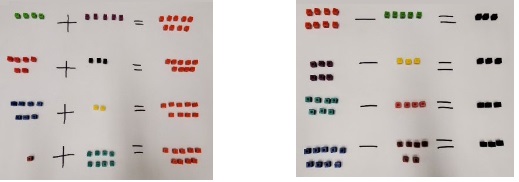Benchmark Instructional Guide
Connecting Benchmarks/Horizontal Alignment
Terms from the K-12 Glossary
- Automaticity
- Expressions
- Equations
Vertical Alignment
Previous Benchmarks
Next Benchmarks
Purpose and Instructional Strategies
The purpose of this benchmark is for students to continue through exploration and reliability towards efficiency and eventually automaticity. In Kindergarten, students added two one-digit numbers with sums from 0 − 10 and they subtracted by using related facts with procedural reliability. Instruction for Kindergarten focused first on exploring to build understanding, then students focused on selecting reliable methods.- Instruction focuses on the fact that automaticity is usually the result of repetition and practice.
- Instruction of this benchmark should not be in isolation from other benchmarks that emphasize understanding.
- Instruction should not focus on speed or competition in the classroom.
- The correct way to assess automaticity is to observe students within the instructional setting as they complete problems that involve addition and subtraction. Even though such problems can typically be done without automaticity they will be done with less effort with automaticity.
Common Misconceptions or Errors
- Students may encounter difficulty with knowing all the ways a number can be decomposed. In these cases, it is helpful to let students explore decomposing a given number such as 9 and having them find all the possible ways to get to nine when adding (0 + 9, 1 + 8 and 2 + 7).
- Students may inappropriately substitute automaticity for understanding when understanding of context is required.
- For example, a student may see a problem containing the numbers 5 and 3 and automatically think the answer is 8 without first using their understanding to determine what operation is required for the context of the problem.
Strategies to Support Tiered Instruction
- Teacher provides instruction with the addition expression, 4 + 5 and has students provide the sum. Once students have given the correct sum of 9, teacher asks “Is there another fact with the same sum?” If students are able to provide another addition expression, ask them to find another one. Repeat with subtraction expression, 8– 5. Students should provide the difference of 3. Students may need to use manipulatives to assist in determining the difference. Once students have given the correct difference, teacher asks “Can you give me a related subtraction equation?”

- For example, the teacher asks students to create a real-world scenario using a set of given numbers, 4, 3 and 7. Once students have provided an appropriate real- world scenario, discuss what might happen with the problem if the scenario is changed to the inverse operation. The teacher may find that students are not creating a true equation from the scenario they shared. Consider discussing how the numbers are related and how they are affected when the inverse operation is used.
- Teacher provides a manipulative like two color counters, asking students to create a
representation of 6. Depending on how they represent the number six, the teacher has students separate the counters into two addends.
- For example, they may have 6 red counters and 0 blue showing. The equation is 6 + 0 = 6. Ask them how they could create a different representation, but with the same sum. Continue this manipulation of the counters until student can identify all sets of two addends that equal 6.

- Teacher provides a real-world problem using numbers up to 10.
- For example, Gavin has 8 toy cars. His brother takes 3 of his toy cars. How many toy cars does he have now? Students can use a manipulative to helps solve the problem. Teacher can act out the scenario with students. Then, the teacher represents the problem in an equation.
Instructional Tasks
Instructional Task 1 (MTR.4.1)
- Part A. Ryan has 8 apples. His dad asked him to put the apples into 2 baskets. What are all the ways Ryan could put the apples into the baskets?
- Part B. With a partner, compare your ways and see if you found all the ways Ryan could have put the apples into the baskets.
Instructional Items
The following items give examples of simple problems that can be used to observe automaticity in the classroom.
Instructional Item 1
a. 9−5=4b. 8−5=3c. 8−2=6d. 7−5=2
Instructional Item 2
Create two addition equations and two related subtraction equations using only the digits 4, 7 and 3.
Instructional Item 3
Which of the following addition expressions have a sum of 10?a. 8+2b. 5+4c. 1+9d. 6+3e. 3+7f. 4+4
*The strategies, tasks and items included in the B1G-M are examples and should not be considered comprehensive.
Related Courses
Related Access Points
Related Resources
Lesson Plans
Perspectives Video: Experts
Student Center Activities
Worksheets
Student Resources
Worksheet
Parent Resources
Perspectives Video: Expert
Explore strategies students may use to solve basic addition facts and ways to support their understanding by watching this video.
FCR-STEM’s Count Us In! initiative is designed to support out-of-school providers and parents in fostering math success and enjoyment among K-5 children.
Type: Perspectives Video: Expert
Student Center Activities
In this game, students develop fluency with addition or multiplication facts and strengthen number sense through fast-paced problem-solving.
FCR-STEM’s Count Us In! initiative is designed to support out-of-school providers and parents in fostering math success and enjoyment among K-5 children.
Type: Student Center Activity
In this game, students bop balloons into the correct basket by solving math facts and matching them to their answers to strengthen fluency through movement-based play.
FCR-STEM’s Count Us In! initiative is designed to support out-of-school providers and parents in fostering math success and enjoyment among K-5 children.
Type: Student Center Activity
Worksheets
Addition Flash Cards Single Digit Numbers Answers to 10
Type: Worksheet
Subtraction Flash Cards Related to Addition with Single Digit Numbers with Answers to 10
Type: Worksheet









